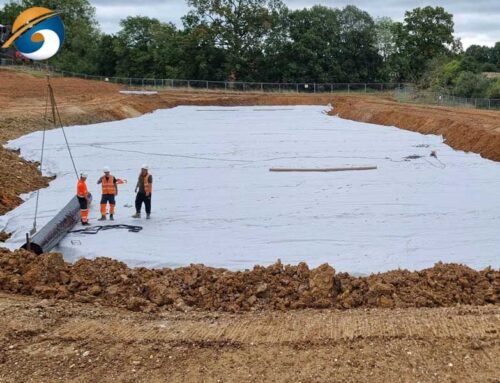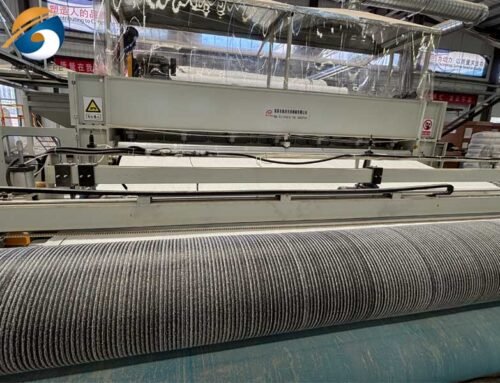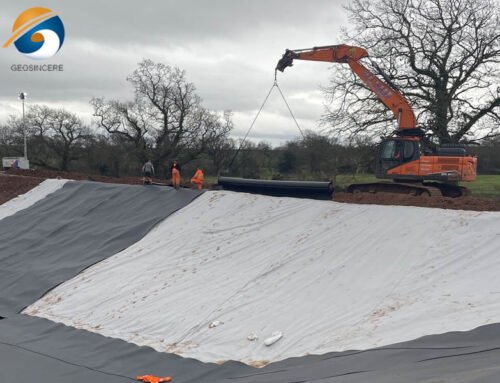Every pond liner’s important job is to hold your pond’s water. HDPE Pond liner is an aesthetically pleasing and functional addition to any structure, whether used for decorative landscaping or aquaculture, such as fish farm and shrimp farm . However, to ensure their longevity and proper functioning, they need to be adequately protected from leaks and water seepage. High-density polyethylene pond liners offer a reliable solution to these challenges.
Chemical resistance, flexibility, cost, and toxicity to fish can all vary as well. Many geomembrane liners are designed for large lakes or landfills, and as a result they may not perform as well in smaller backyard ponds. As the leading Geomembrane manufacturer and supplier, GEOSINCERE offers a wide range of HDPE Pond Liner material in custom thickness and size at best factory price.For these reasons, it pays to know a little about different liner materials before you invest in one.This article will take an in-depth look at HDPE pond liners, exploring their features, benefits, and applications:
1. What Is HDPE Pond Liner?
HDPE pond liners are impermeable geomembranes used to line water structures, preventing water seepage and maintaining water levels. Made of high-density polyethylene plastic, these liners are durable and resistant to chemicals and UV exposure.HDPE is suitable for large water bodies due to its UV resistance, strength, and stiffness. It resists sudden tears and a wide range of chemicals, making it a popular choice worldwide.HDPE pond liners are used in various settings like artificial ponds, irrigation systems, fish hatcheries, and industrial containment sites. They offer long-lasting solutions with their durability and resistance to UV rays, punctures, and chemicals.HDPE Pond Liner is available in 0.2mm-3mm. You can determine the thickness you need based on your needs.


2. What Are Advantages Of HDPE Pond Liner?
High-Density Polyethylene (HDPE) pond liners offer several advantages for pond construction and water containment. Here are some of the key benefits of using HDPE pond liners:
2.1 Durability:
HDPE pond liners are highly durable and resistant to punctures, tears, and UV radiation, ensuring long-term performance and structural integrity.
2.2 Chemical Resistance:
They are resistant to a wide range of chemicals commonly found in soil and water, making them suitable for various aquatic and environmental applications.
2.3 Flexibility:
HDPE liners are flexible and can conform to the shape of the pond without losing their integrity, allowing for easy installation and adaptability to various designs.
2.4 Seamless Installation:
HDPE liners can be prefabricated into large panels, minimizing the need for field seams and ensuring a seamless and leak-proof installation.
2.5 Low Permeability:
HDPE liners have low permeability, reducing the risk of water seepage and maintaining water levels in the pond.
2.6 Environmentally Friendly:
HDPE is a non-toxic material that does not leach harmful substances into the water, making it safe for aquatic life and environmentally friendly.
2.7 Cost-Effective:
While the initial cost of HDPE liners may be higher than some alternatives, their durability and long lifespan make them a cost-effective choice in the long run.
3. What Are Disadvantages Of HDPE Pond Liner?
While High-Density Polyethylene (HDPE) pond liners offer numerous advantages, there are also some disadvantages associated with their use. Here are some potential drawbacks of HDPE pond liners:
3.1 Initial Cost:
HDPE pond liners can have a higher upfront cost compared to some other liner materials, which may deter individuals or organizations with budget constraints.
3.2 Temperature Sensitivity:
HDPE liners can become brittle in extreme temperatures, leading to potential cracking or damage if not properly installed or protected in regions with significant temperature fluctuations.
3.3 UV Degradation:
Although HDPE liners are UV-resistant, prolonged exposure to sunlight can still cause degradation over time, necessitating the use of protective coatings or shading in some cases.
3.4 Puncture Risk:
While HDPE liners are generally durable, they can still be susceptible to punctures from sharp objects or roots if not adequately protected or maintained.
3.5 Seaming Challenges:
Seams in HDPE liners can be vulnerable points for leakage if not properly welded or sealed, requiring skilled installation to ensure watertight seals.
3.6 Creep:
HDPE liners may exhibit some degree of creep over time under constant loading, which can affect their long-term performance if not accounted for during design and installation.
3.7 Limited Repair Options:
Repairing damaged HDPE liners can be challenging and may require specialized equipment and expertise, particularly for large-scale repairs.
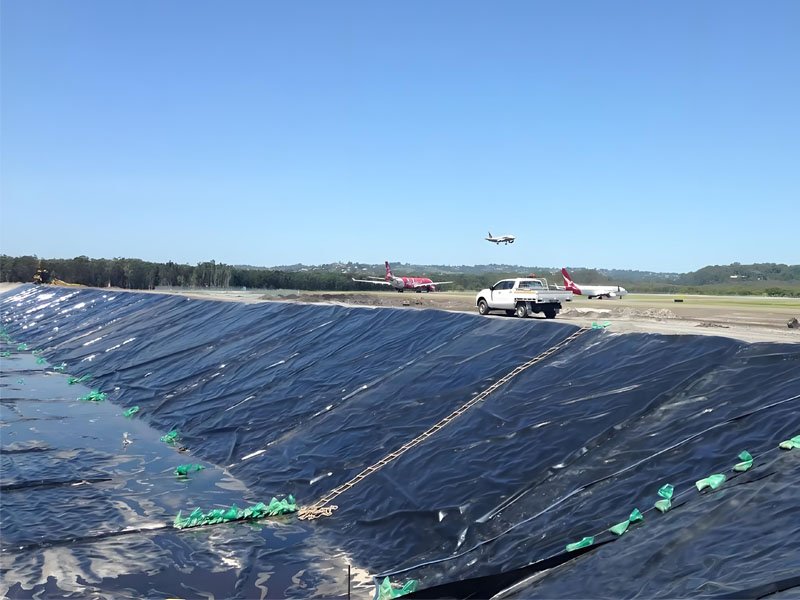
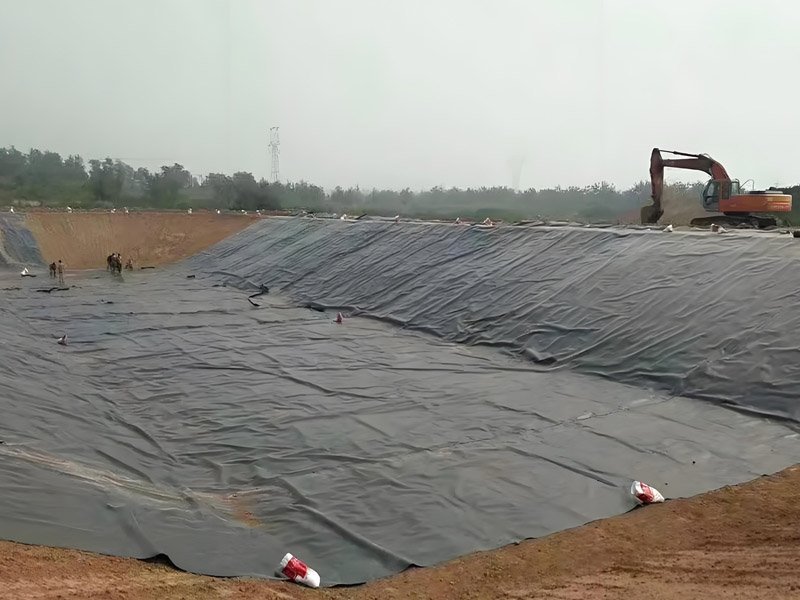
4. What Are Applications Of HDPE Pond Liner?
High-Density Polyethylene (HDPE) pond liners are versatile materials suitable for various applications in water containment and environmental protection. Some common applications of HDPE pond liners include:
4.1 Decorative Ponds:
HDPE liners are used in constructing decorative ponds in residential gardens, parks, and commercial landscaping projects.
4.2 Fish and Aquaculture Ponds:
HDPE liners create a suitable environment for fish and aquatic life in fish ponds, aquaculture facilities, and hatcheries.
4.3 Water Storage Reservoirs:
HDPE liners are utilized in the construction of water storage reservoirs for agricultural, industrial, and municipal water supply purposes.
4.4 Stormwater Management:
HDPE liners help in the containment and management of stormwater runoff in retention ponds, detention basins, and erosion control structures.
4.5 Wastewater Treatment:
HDPE liners are used in wastewater treatment facilities, lagoons, and containment systems to prevent contamination of surrounding soil and groundwater.
4.6 Landfill Liners:
HDPE liners serve as impermeable barriers in landfill construction to contain leachate and prevent groundwater contamination.
4.7 Mining and Industrial Applications:
HDPE liners are used in mining operations, industrial ponds, and tailings storage facilities to contain and manage process fluids and waste materials.
4.8 Irrigation Reservoirs:
HDPE liners are employed in agricultural irrigation reservoirs, canals, and irrigation ponds to store and distribute water for crop irrigation.
5. Summary
HDPE pond liners, despite their advantages, have some drawbacks. They can degrade under UV exposure unless protected by soil or other materials. Punctures and tears, especially during installation or from sharp objects, can lead to costly repairs. Chemical leaching may also affect water quality and aquatic life. While HDPE liners are cost-effective, installation and protective measures can add to the expense. Proper installation and maintenance are crucial for durability and longevity, and any errors can compromise the liner’s performance.
GEOSINCERE brand HDPE pond liner and other geosynthetics products and solutions can meet your requirements by our solid technologies, innovative engineering solutions and excellent customer services.If you have any questions, please contact us.



